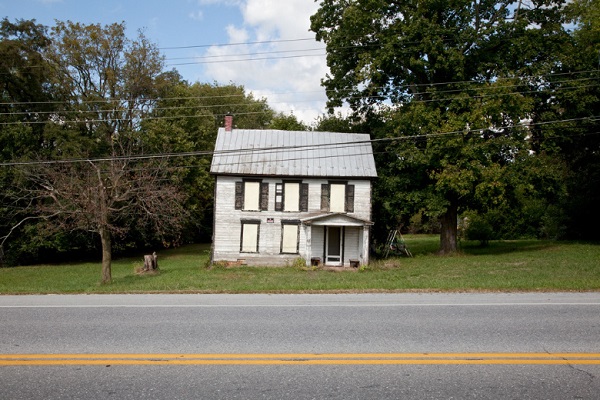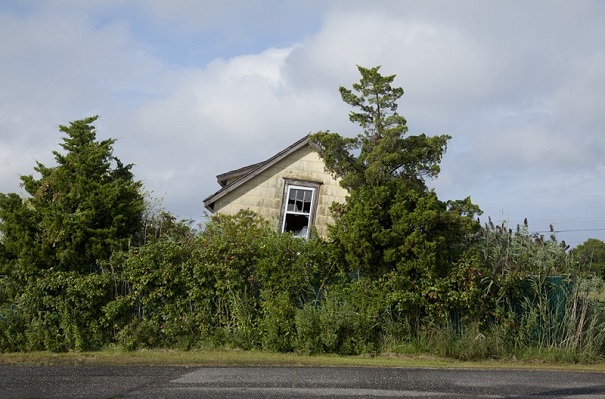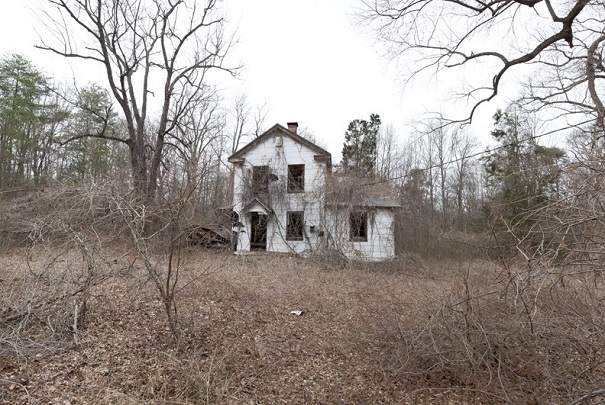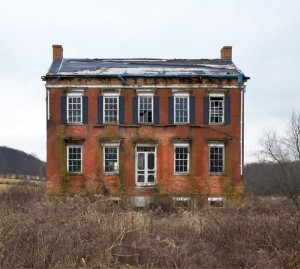Artist of the Week 11/6-11/12: A Photographer Apart: Ben Marcin Captures What Might Be the Last Documentation of Lone Structures across the North East
GALO: In both the Last House Standing and A House Apart series, the objects photographed appear to be slanting — houses caving into themselves, the upward tilt of the sidewalk, or the house itself leaning slightly. Are the leaning buildings a metaphor for the weakness of isolation in a collapsing society? Were you perhaps trying to make a statement that the North East, which used to be a bustling community, is falling apart due to worsening economy throughout the last century?
BM: Some of it is for sure. We are the greatest country in the world, but then you go into the middle of some of the great cities here, and it is sort of falling in on itself. I hope not all the houses are leaning [laughs]! But I am sure some of them are. Remember, they were meant to be standing about five houses on each side. So when you take away the houses, they are 15 feet wide by 40 feet tall; they aren’t meant to stand like that. So between their age and without the support, some of them lean a little bit.
With the abandoned houses, however, you will see the leaning. In the wooden houses, you see them slowly limping and leaning over, like an old person. They are hunchbacked, but they are hanging on there. This series is not so much about the house. I do love the characters of the houses, but it is a memento to someone’s life. Generations of people lived there, but now it is over. It is slowly just tilting over, until one day there will be a Walmart there. Imagine just driving away from your house — not leaving it to anyone, just driving away, that’s it, you’re done. Or maybe you died there. Whatever reason, it is really about the ghosts of the people that lived there.

A photo taken of a house in Hagerstown, MD for the “A House Apart” series by Ben Marcin. Photo Courtesy of: Ben Marcin.
GALO: Comparing both the Last House Standing and A House Apart series, is A House Apart in some ways the antithesis to Last House Standing? That is, did the remaining structures in Last House Standing represent the result of communities collapsing, whereas the solitary buildings in A House Apart represent the result of surrounding communities growing?
BM: Absolutely, that captures it perfectly! In one case, the community is becoming devastated, and in the other case, the development is approaching and folks are leaving. Soon, you will see new townhouses and new developments there. The other thing is that they physically changed. The row houses, although now they are solo like the A House Apart houses, for over 100 years, they were not [solo]. You wouldn’t have even noticed the one that I shot in a row of houses. Now, you definitely notice it because it is standing there by itself like a tank, like a monument. The other houses were always intended to be apart. Those people were real loners. They wanted to be left alone; they were very private, and they didn’t want neighbors. So that’s the difference.
GALO: While walking around the surrounding territory of these homes and admiring their decaying beauty from the outside, did you feel a desire to explore the inside of these archaic buildings?
BM: Not at all. Nope. There are practical reasons for that! In the case of the row houses, a lot of these things are used by drug dealers, and it’s not a good idea for somebody like me to be going inside. The police might be watching, or somebody’s in there, like that one guy who came out on me when I thought it was an abandoned house! Good thing I didn’t try the door! In terms of the houses out in the country side, when you go inside, it is almost disappointing. There are people who have taken photographs on the insides of some of these things; I didn’t want to do that. I preferred the exterior and the surrounding area around it. Once you get on the inside, it is just clutter and junk. I really wanted to capture the exterior. I wanted you to look at these photos and see the house in dead center with nothing on the left, nothing on the right, a bunch of trees growing in through the roof now, and think to yourself: why would anyone have lived here to begin with, and what happened?

A photo taken of a house in Surf City, NJ for the “A House Apart” series by Ben Marcin. Photo Courtesy of: Ben Marcin.
GALO: What impression of America does your photography leave you with? Since you are encapsulating urban decay, have you found that the urban decay you highlight in your photography is something you find to be uniquely American, or do you see this decomposition as a worldwide phenomenon, given your experience growing up on another continent? How would your series have changed if you chose to photograph in Europe, or another place you have traveled instead?
BM: I travel a lot, and you see this quite a bit in Greece, Iceland, and other places I have traveled. While it can be interesting there, in the United States, it is a little unexpected, right? We are a great country, and we have all these resources, and yet we also have a lot of poverty and a lot of disconnect between the rich and the poor. These houses reflect that. Those houses were built to last forever; I live in one! I live in one of these row houses! I live in a house that was built in 1880, and the thing is granted [sic]. If they are taken care of and well-maintained, they will last forever.
It is like looking at an old person, and just knowing that she was a beauty in her 20s or 30s. You can just see the effects of the ravages of time and the things out of your control, but you can still see the twinkle — some of the houses still have these details and that little twinkle in them. It’s a shame — it wasn’t their fault [laughs]. If I chose to photograph anywhere else, the vernacular and the architectural style would be different. I am also more interested in it here because I live here. Having done this here, I would love to go back to Europe because the buildings are a lot older. Or, if you go to China, they are tearing down these really ancient homes in the middle of downtown Shanghai and Beijing and putting up these big corporate high-rises. I would love to document some of that. I imagine it would be similar to this series, but these row houses are very typically American. If I did it in Greece, I would get something that looked like Greece.

A photo taken of a house in Severn, MD for the “A House Apart” series by Ben Marcin. Photo Courtesy of: Ben Marcin.
GALO: In the photos from the new series you are working on, in which you are photographing lone homes out west, you left much more space on the left and right of each photograph. Why did you choose to show more of the setting with these photographs?
BM: I had a lot more room to move with. With the row houses, I could really only go across the street because I usually had a house behind me where I was standing, so I only had about 30 yards. Out west, in eastern Colorado where all those photographs were taken, I could have gone back five miles, and I would still see that house, and there would be no neighbors [laughs]! So, there I had the luxury of taking a receding standing point. There, you really get the sense that these folks really wanted to be left alone. Sure, the people in A House Apart wanted to be left alone, but these folks out here — my God, they were loners! They wanted to farm this land, live by themselves like “please don’t call us, don’t knock on our door.” It is almost exaggerated. This is a new series; I just started it this summer. A lot of the same things that are going on in my other two series are going on here.
The C. Grimaldis Gallery in Baltimore will be exhibiting “Ben Marcin: Last House Standing (And Other Stories) from December 18, 2013 to January 25, 2014. For more information, please visit http://www.cgrimaldisgallery.com/2013/09/21/ben-marcin-2/.


